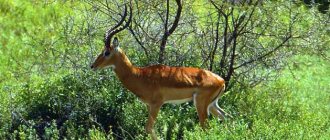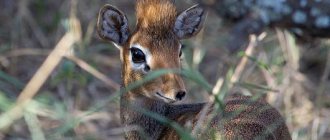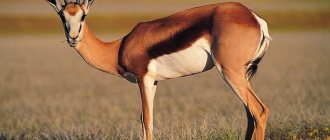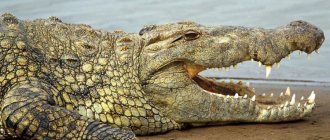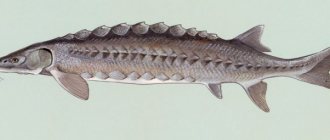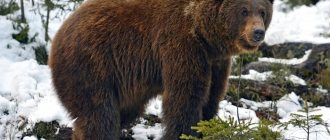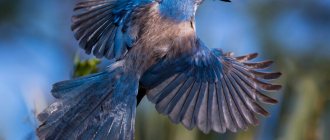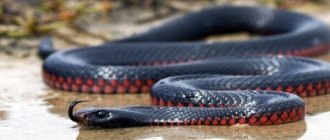Characteristics and description
Antelopes are social animals. They form herds, the number of which can range from several animals to several hundred individuals. The severity of the hierarchy in the herd also varies greatly. In most species, the dominant position is occupied by the male, while in small groups he may be the only sexually mature male.
Many antelopes are characterized by seasonal migrations in search of more fertile pastures. They prefer to feed during daylight hours, since during the day it is easier to notice danger. When predators appear, animals flee and, in extreme cases, use their horns for defense.
Horns
No other species of artiodactyl has such a variety of shapes, colors and lengths of horns as antelopes. Thus, in saber-horned antelopes (addax, oryx, oryx), they are very long, arched and curved back. In the steppe hartebeest, the horns grow from one base and bend outward and upward in the shape of a crescent. The four-horned (or Indian) antelope has two pairs of horns, with the front pair being small and almost invisible, and the back pair reaching 10 cm.
The length of the outgrowths can vary from a few centimeters to a meter.
What does it look like
Despite the many different varieties, the appearance of antelopes has several common characteristics:
- the body is elongated, rounded in section;
- the legs are long, strong, but thin, making even large animals seem more graceful;
- the neck is quite long, the head is medium-sized with an elongated muzzle and large ears directed to the sides, which is why gazelles look protruding.
The color is dominated by various variations of brown. Most species have a darker upper body and a lighter belly. Many antelopes are characterized by masks on their faces, stripes and spots.
How many years do they live
The lifespan of antelopes directly depends on their size. The largest animals can live up to 16-20 years, while the age of pygmy antelopes rarely exceeds 8-10 years.
Lifestyle and character traits
Life in arid savannas and hot steppes is subject to its own cruel laws. The night here belongs to predators, so the herbivorous inhabitants go out to feed during daylight hours. And antelopes were no exception in this regard; moreover, they have perfectly adapted to the grueling heat and scorching African sun. These ungulates graze throughout the day, but their peak activity occurs in the morning and evening.
Antelopes sleep very little, allowing themselves to spend no more than 3-4 hours a day on rest. Their sleep is sensitive and restless, and at any suspicious rustle the animals quickly jump out of place and run away.
Social and territorial structure of antelopes
Large antelopes living on open plains gather in herds, the size of which depends on the time of year and the availability of food. Typically, they form groups of 25-40 individuals, although in favorable periods the number of bovids in the herd can increase to 1000 individuals. But such huge groups of antelopes are temporary, and their associations do not have friendly or family ties. Often, animals gather in large herds when moving to new pastures or during seasonal migrations, and then break up again into smaller groups.
Together we are safer and more reliable
Recommended by topic
Weasel Coyote Hamster
As for the social structure of antelopes, the societies of most varieties of these ungulates are structured the same. Their clans are formed from several mature females and cubs, and a strong male dominates such a “harem”. Young bachelors stay in a separate group, old males also gather in separate groups. Large antelopes have no such thing as their own territory; they are not tied to one place and constantly roam in search of fresh vegetation.
African and Asian bovids have a patriarchal structure, but in the American pronghorn community there is partial matriarchy. In normal times, females with young animals and adult males live in small separate clans. In the fall, pronghorns gather in a huge herd and migrate south, and an experienced mature female leads the animals. Interestingly, there is no place for elderly males in their group, and the horned “pensioners” are forced to travel alone, at the risk of becoming prey for predators.
By the way, not all antelopes like herd life. Miniature bovids, unlike their large relatives, prefer solitude or create strong marriages. For example, antelopes from the duiker subfamily live solitarily and are found only during the breeding season. And dik-diks form families consisting of a female, a male and cubs. Each pair of small antelopes owns their own territory, the boundaries of which they mark with piles of dung, and aggressively drive away all uninvited guests from their territory.
Character and habits
Antelopes can be described as peace-loving animals with a calm and gentle disposition. These creatures are not prone to aggression, and conflicts rarely arise within their community. Of course, during the mating period, spectacular fights take place between the horned males for the right to own the female, but the rest of the time, the antelopes get along quite peacefully with their relatives and do not quarrel over food and territory. Antelopes also maintain good neighborly relations with other herbivores and often graze in the company of zebras, giraffes and elephants.
Wildebeest herd in the sunset sun
In general, antelopes are timid and skittish creatures that always have to be on their guard. From the outside it seems that they are leisurely nibbling the grass and are not particularly interested in the world around them, but their feigned equanimity is deceptive. These bovids constantly scan their surroundings using their stereoscopic vision, keen hearing and keen sense of smell. After all, hungry predators roam around the antelopes, just waiting for the opportunity to pounce on the unguarded ungulate.
Antelopes have nothing to oppose the teeth and claws of their enemies, so when they see a predatory beast, they rely on their fast legs and try to escape. Yes, most antelopes have long, sharp horns, but herbivores simply do not have time to use them. After all, their four-legged opponents are well aware of such formidable weapons of their victims, and attack the ungulates from behind, trying to knock down the prey in one jump.
Impressive leap of an antelope
However, antelopes have several secrets of survival, and not every predator is able to catch such a fleet-footed animal. During feeding or resting at night, herds of bovids have several sentinels whose task is to closely monitor the surroundings and notify their relatives of the approaching enemy. Seeing a sneaking cheetah or a pack of hyenas, the guard emits a special signal, and the whole group scatters. By the way, when fleeing, antelopes maneuver, jump from side to side and change their trajectory as they move, thereby confusing their pursuers.
Among all the antelopes, only the Wildebeest are distinguished by their unpredictable and violent temperament. Animals can calmly devour juicy grass, and the next moment the herd takes off and rushes across the savannah, without discerning its path. Having run several tens of kilometers, the Wildebeest also suddenly calm down and, as if nothing had happened, return to their meal. They are also prone to unreasonable fits of rage. Here is a group of antelopes eating plants, and suddenly one of them begins to jump up and ferociously attack its fellow tribesmen and neighbors in the pasture. Such outbursts of anger last for several minutes, after which the ungulate humbly takes its place in the herd again and continues the interrupted lunch.
Question to the expert
Can antelopes swim?
Yes, antelopes can swim and are able to stay in deep water tolerably. But these animals try not to enter the rivers, because they are afraid of the crocodiles living in them. Antelopes cross bodies of water only during migrations, and if there is no other way.
Types of antelope: photos and names
In the biological classification, there are about a hundred species of antelope. Among them there are bovid representatives of the fauna of the most diverse sizes and appearance. Let's look at the most interesting types.
Wildebeest
Connochaetes taurinus
Belongs to the subfamily of cow antelopes. You can recognize her by the elongated shape of her head. The wildebeest inhabits savannas located south of the Sahara.
The genus includes two subspecies: blue and white-tailed wildebeest. Animals form numerous herds, the number of individuals in which can reach several hundred. Twice a year, wildebeest migrate from savannas to forests and back in search of lush young grass.
Bongo
Tragelaphus eurycerus
Quite a large antelope with long spiral-twisted horns. It lives in forests located in the center of the African continent. Bongos are easily recognized by their unusual striped coloring: the animal’s chestnut-red fur has clearly visible light transverse stripes along the entire length of its body.
Impala
Aepyceros melampus
Also known as the black-footed antelope. A medium-sized animal with lyre-shaped horns reaching 1 m in length. Its habitat occupies a vast area in the southeast of the African continent. Black-footed antelopes live mainly in savannas.
Hiding from the pursuit of enemies, impalas are capable of making jumps up to 3 m high and up to 10 m long, while the jumping animal seems to hover for a moment at the highest point, legs bent and head thrown back.
Horse antelope
Hippotragus equinus
Large animals, whose weight can reach 300 kg. This species is characterized by a black mask on the face and a mane stretching from head to back. Horse antelopes live in small groups of 10-12 individuals. The dominant male protects the herd, and the dominant female looks for pastures and resting places.
Garna
Antelope cervicapra
Asian antelope of medium size. For its long (up to 70 cm) and spirally twisted horns, it received a second name - the horned antelope. The back of the animal is dark, almost black, and the belly and inner parts of the limbs are white.
Garns are very hardy and, if necessary, can reach speeds of up to 96 km/h.
Jeyran
Gazella subgutturosa
Small-sized animals, the maximum weight of which is 30 kg. Males have lyre-shaped horns covered with transverse rings. A characteristic feature of the species is the habit of raising its tail while running.
In their habitats, goitered gazelles were hunted for a long time, which led to the complete extermination of the species in some areas. Currently, antelopes can be found in the Kazakh steppes, some regions of Georgia, and the deserts of Iran and Afghanistan.
Saiga antelope
Saiga tatarica
An antelope with an elongated hook-nosed muzzle. The horns are small, translucent, and located vertically. Saiga antelopes are characterized by a seasonal concentration of individuals, when herds of thousands gather in the most food-rich areas. Uncontrolled shooting and periodic epizootics have led to the fact that saigas are currently on the verge of extinction.
Pronghorn
Antilocapra americana
The pronghorn antelope is the most ancient representative of American ungulates. These are medium-sized animals with long, hooked horns.
The increased endurance of the pronghorn is ensured by a thicker trachea and larger lungs, as well as an increased heart size.
Roe deer antelope, or pelea
Roe deer antelope, or pelea (Pelea capreolus) is a resident of South Africa. It has a length of 1.15 to 1.25 m and weighs between 20 and 30 kg. Roe deer antelope is active during the day and tries to rest in the shade at midday. These antelopes can form two types of social groups. The first consists of females and one dominant male (usually about 8 animals, but can reach 30). Another social group consists of solitary males. During mating, fights often occur between dominant and lone males, and often one of the participants in the fight may be killed.
Dimensions and weight
Representatives of different species of antelope differ from each other not only in the structure of their horns, color and behavior, but also in size. The height and body weight of some adult animals from various genera and families are given below.
| Type name | Height, cm | Weight, kg |
| Eland (ox) | 150 | 500 |
| Nilgai | 130 | 200 |
| Swamp | 120 | 130 |
| Bushbuck | 100 | 80 |
| Nyala | 110 | 65 |
| Thompson's antelope | 80 | 35 |
| Oribi | 70 | 20 |
| Dik-dik | 40 | 5,5 |
Western eland
Popularly known as the Öland giant antelope, these antelopes have spiral horns and are commonly found in the open forests and savannas of Africa. Belonging to the genus Taurotragus and members of the family Bovidae, the giant antelope of Öland are the largest species of antelope currently existing on earth. These are herbivores that form small herds of 15 to 20 individuals. Western elands are generally non-territorial and have a large home range. Although they mate throughout the year, their peak mating season is the rainy season.
Where do they live?
About 5 million years ago, the habitat of antelopes extended to the entire African continent, most of Europe and Asia. Currently, the range has decreased significantly: in addition to Africa, animals are found only in some regions of South Asia.
ZEBRA
Where live
The habitat of antelopes can be very diverse: from densely vegetated forests and mountainous areas to savannas, steppes and semi-deserts.
Habitat of the antelope
Antelopes have adapted perfectly to a wide variety of climates and living conditions. While some prefer steppes and deserts, others prefer forests or savannah.
The geography of the places where the antelope lives is quite extensive. This is mainly Africa and South Asia, with greater species diversity in Africa. But they can also be found in Central Asia, North and South America. It all depends on the species.
For example, the African antelope lives in Africa because it is accustomed to a dry, hot climate, hence its name. She is accompanied by wildebeest, great kudu, Grant's, Thompson's, Speke's gazelles, impala, dorcas and many others. These animals chose deserts, semi-deserts and steppes to live because in open areas it is easier for them to detect a sneaking enemy in time and escape by running to a safe distance.
The semi-deserts of Central Asia were chosen by the steppe antelope and saiga, and the oryx preferred the deserts of Arabia, for which it received the name Arabian.
The forest area was chosen by nyala, baby dik-dik and duiker, as well as eland antelope for their residence. This species is a kind of symbiosis between a goat and a bull. And this makes this breed special - they feel comfortable both in forests and in the mountains.
The mountains are home to the most courageous antelopes, such as chamois, which live on the snowy peaks of the Caucasian and Alpine mountains, or African sassos, considered one of the best jumpers. They can easily jump over the steepest rocks and can easily jump over wide chasms.
What do they eat?
Antelopes are herbivores. Dividing the stomach into several sections helps them extract the greatest amount of nutrients from plant foods.
The diet includes grass, young shoots and leaves of bushes or trees. Some antelopes eat berries and seeds of various plants, as well as mosses and lichens.
Animals that are unpretentious in food remain in the same territories, changing their diet depending on the season. Species that are selective in food can undertake long seasonal migrations in search of certain plants.
Antelopes get most of their fluid from food, so they can go without water for a long time.
LAMA
Hunting and poaching
One hundred and fifty years ago, saigas inhabited the steppe regions from Ukraine to Lake Baikal, but by the beginning of the 20th century they survived in Russia only in the Volga region and Kazakhstan. This was such a monstrous extermination of the species that Lenin issued a special decree banning the hunting of antelope, which was not slow to affect the sharp increase in the number of nomadic herds.
By the mid-20th century, the saiga population had grown to two million. Obviously, both the ban on shooting antelope and the extinction of a dangerous parasite for animals - the saiga gadfly - had an impact. During this golden period, huge herds of margaches constantly roamed along all their migration routes. In the mid-fifties, commercial hunting of saigas was again allowed.
This situation changed in the 70s, when the active development of vast territories that were former habitats of saigas significantly reduced their range. The construction of pipelines, road construction, land reclamation, and mining disrupted the usual way of nomadic life, interfering with the natural migration routes of artiodactyls, and the number of saigas again decreased so much that hunting them was again prohibited. Antelopes have mastered the Kalmyk open spaces.
The collapse of the Soviet Union had a ricochet effect on the population of these animals. If previously the species lived on the territory of one state and was protected by it, today the saiga antelope is an animal that lives in several countries that have not signed a single document of international conventions on the protection of rare species. Uncontrolled shooting of animals and poaching are scourges that the largest packs of wolves cannot compare with. The extermination of the saigas population, first for meat and then for the horns of males smuggled into China, led to a catastrophic drop in the number of antelopes, amounting to only 35 thousand individuals. This is very small, considering that the vast majority of surviving antelopes are females.
How do they reproduce?
The breeding season for antelopes is tied to the season. Usually babies are born after the rains, when the pastures are covered with dense young vegetation.
Small varieties of antelope are polygamous; males of large varieties collect harems of several females during mating. The duration of pregnancy is from 5.5 to 9 months.
Before giving birth, the female sets up a shelter in dense thickets, under stone sheds or in another secluded place. Antelopes usually give birth to one baby at a time. After birth, the baby immediately stands on its feet and begins to suck mother's milk. In some varieties, the cubs begin to follow the female on the very first day, in others, in the first days they hide in thickets of grass or bushes.
After 2-3 months, the babies begin to graze, and after another six months they become completely independent. Young antelopes living in numerous herds remain in the parental group. Species that form small groups usually expel young that become independent.
Gon
With the beginning of winter, rutting time begins. During this period, males lose their appetite and become very agitated. They are especially aggressive; fierce fights occur between them, during which serious wounds are often inflicted, sometimes leading to the death of one of the participants in the fight.
Each male marks his own territory, leaving litter, and builds his own “harem” of females won in battles with fellow tribesmen, the number of which can vary from 5 to 50 heads. Their number depends on the strength and activity of the male. In addition, he is forced to constantly confirm his right to own a harem. Another male can claim the “wives”, and then the fight starts again. If the owner of the harem loses, the winning margach takes away several females.
Enemies in nature
In their natural habitat, antelopes very often become victims of large predators. Most often, young, weakened and old animals, as well as individuals straying from herds, suffer from attacks.
Natural enemies of antelopes include lions and other large cats, hyenas, jackals, wolves, and wolverines. When drinking water or crossing rivers, herbivores become easy prey for crocodiles. Groups of antelopes moving in open areas are attacked by birds of prey: falcons, vultures, eagles, golden eagles and peregrine falcons.
Reproduction and lifespan
The Kalmyk antelope does not live long; the life expectancy of females and males is different. Males live 4-5 years, females have a longer life span of 8-9 years. But the reproductive function of antelopes is incredible: they reproduce very quickly. Already at the age of seven months, females reach sexual maturity and participate in the rut, bringing their first offspring at one year of age. Males reach maturity only at 2.5 years.
Annual calving occurs in May. Pregnant females, grouping into a flock, leave the herd, choosing for calving the most remote areas of the steppes with little or very sparse vegetation and the absence of water bodies, i.e. places where predators do not look. Without arranging any special secluded corners, they give birth right on the ground.
The first female heifer usually gives birth to one calf, while older individuals give birth to 2-3 babies. The first days they are absolutely helpless, lie on the ground and practically do not move, merging with the general background of the area due to their own coloring. Nature has taken care of them, giving them the opportunity to be unnoticeable at the most vulnerable moments of life, which often saves them from attacks by natural enemies - ferrets, foxes, eagles or other predators, when approached, the baby freezes, merging with the ground so that it is very difficult to see. Saiga babies are probably the most obedient babies in the world. Without moving, they lie on the ground and wait for their mother to come and feed them. Females graze at this time, visiting the babies several times a day.
After a week, the baby saiga, the photo of which is presented above, is already relentlessly following its mother, after two it can run, developing the speed of an adult, and after a month it begins to pluck grass.
Population status
One of the main reasons for the decline in the number of antelopes is human economic activity and the uncontrolled shooting of healthy animals of reproductive age. Species whose populations are currently in critical condition include beira, Hunter's bubal, roe deer antelope, beisa, dibatag, mendes antelope.
All of them are listed in the International Red Book and are protected. In order to restore the number of antelopes, natural parks and reserves are being created in many countries. Thanks to the measures taken, it was possible to increase the number of Saharan oryx, lesser kudu and several other species.
GIRAFFE
Oryx
Popularly known as the gemsbuck or the South African oryx, the oryx belongs to the genus Oryx and is a member of the family Bovidae. They live in the desert regions of South Africa, mainly in the Kalahari Desert, and are depicted on the coat of arms of the country of Namibia. These beautiful antelopes are the largest Oryx species in the world and are hunted by people for their magnificent horns.
Interesting facts about antelopes
- Among the bovids there are very miniature animals. In Suni antelopes, for example, the height at the withers is only 35 cm, and the body weight is in the range of 4.5-5 kg. However, this small animal is not the smallest antelope in the world. The real record holder is the dwarf (or royal) antelope, whose height barely reaches 30 cm and weighs no more than 3 kg.
- The gerenuk (giraffe) antelope, which lives in Africa, is capable of standing on its hind legs and thus reaching high tree branches. The resemblance to giraffes is given not only by the way they feed, but also by their noticeably elongated neck and long legs.
- The lifestyle of some species of antelope is very different from the behavior of their relatives. For example, the blue duiker (or crested antelope) does not form herds, but lives in pairs. The male and female occupy a certain territory, mark it and protect it from uninvited guests.
- Springbok has the unique ability to jump up to a height of up to 3 m, not while running, as other antelopes do, but from a place.
- Antelopes have stereoscopic vision: they can see danger approaching from behind or from the side without turning their heads. In addition, like most diurnal animals, they distinguish colors.
Appearance
All antelopes have long legs, thin necks and large ears. A universal feature of male antelopes is a pair of permanent horns, used to repel the attacks of predators and establish dominance among representatives of the same species. In about two-thirds of antelope species, females also have horns, although they are shorter and thinner than those of their male counterparts.
Photo: Dharmit Shah
Antelope's antlers are permanent, while deer shed their antlers every year. The bony core of the horns is covered with keratin (the same substance that makes up our hair and nails). Antelope horns come in a variety of shapes and sizes:
- Nine species, including eland, kudu, bongo and nyala, have intricate spiral horns.
- Three species of oryx have long, thin, relatively straight horns.
- Wildebeest horns are curved and pointed at the end.
- The impala's horns have screw-like ridges.
All antelopes have hooves, the shape and size of which reflect the ecological needs of each species. Addax antelopes, which live in the deserts of North Africa, for example, have broad hooves with flat undersides that prevent this endangered species from sinking into the sand. Sitatunga, which live in wetlands, have elongated and widely spaced hooves that prevent the animal from slipping in the mud. The hooves of the Klippspringer, a pygmy antelope, are small and rounded with a rubbery center that allows the animal to stand firmly on rocky terrain.
Natural enemies of wildebeest
Photo: African wildebeest
Wildebeest herds form the basis of the diet for many African people. Predatory cats - lions, leopards, cheetahs - are able to single-handedly kill an adult wildebeest. All they need is to choose a victim, pursue without switching to others, slightly separate from the main herd and grab the throat.
The animal quickly dies from the powerful claws and teeth of predators. The easiest way for them to attack the cubs: they are not so fast, they easily fight off the herd and the felines can easily grab and carry the victim with them. Hyenas are quite small and are not able to kill an antelope alone, but they happily eat the remains of lions and other cats. In a small pack of hyenas they can attack a single animal themselves, then they will have lunch together.
Wildebeest are water lovers; they often and for long periods of time stand on the river bank and drink water. Another enemy is waiting for them there - a crocodile. He can also single-handedly grab an antelope and drag it into the water so that it drowns, then calmly go on to eat. The rotted remains of antelopes are also in demand; they are eaten by scavenger birds, such as griffins. There are especially many of them along the banks of the river, where after the migration of antelopes there are many trampled bodies. Antelopes are also hunted by people for their meat, skin or horns. In the 19th century, antelopes were the main food of colonialists.
